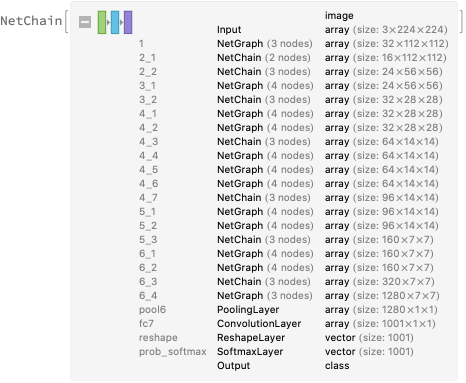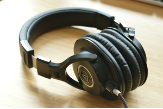MobileNet V2 Trained on ImageNet Competition Data
Identify the main object in an image
Resource retrieval
Resource retrieval
Get the pre-trained net:
In[]:=
NetModel["MobileNet V2 Trained on ImageNet Competition Data"]
Out[]=
NetModel parameters
NetModel parameters
This model consists of a family of individual nets, each identified by a specific parameter combination. Inspect the available parameters:
In[]:=
NetModel["MobileNet V2 Trained on ImageNet Competition Data","ParametersInformation"]
Out[]=
Pick a non-default net by specifying the parameters:
In[]:=
NetModel[{"MobileNet V2 Trained on ImageNet Competition Data","Depth"1.,"Width"224}]
Out[]=
Pick a non-default uninitialized net:
In[]:=
NetModel[{"MobileNet V2 Trained on ImageNet Competition Data","Depth"0.75,"Width"224},"UninitializedEvaluationNet"]
Out[]=
Basic usage
Basic usage
Classify an image:
In[]:=
pred=NetModel["MobileNet V2 Trained on ImageNet Competition Data"]
Out[]=
The prediction is an object, which can be queried:
In[]:=
pred["Definition"]
Out[]=
male peafowl; having a crested head and very large fanlike tail marked with iridescent eyes or spots
Get a list of available properties of the predicted :
In[]:=
pred["Properties"]
Out[]=
Obtain the probabilities of the ten most likely entities predicted by the net:
In[]:=
NetModel["MobileNet V2 Trained on ImageNet Competition Data"]
,{"TopProbabilities"10}
Out[]=
An object outside the list of the ImageNet classes will be misidentified:
In[]:=
NetModel["MobileNet V2 Trained on ImageNet Competition Data"]
Out[]=
Obtain the list of names of all available classes:
In[]:=
EntityValue[NetExtract[NetModel["MobileNet V2 Trained on ImageNet Competition Data"],"Output"][["Labels"]],"Name"]
Out[]=
Feature extraction
Feature extraction
Remove the last three layers of the trained net so that the net produces a vector representation of an image:
In[]:=
extractor=NetTake[NetModel["MobileNet V2 Trained on ImageNet Competition Data"],"fc7"]
Out[]=
NetChain
Get a set of images:
Visualize the features of a set of images:
Visualize convolutional weights
Visualize convolutional weights
Extract the weights of the first convolutional layer in the trained net:
Visualize the weights as a list of 48 images of size 3x3:
Transfer learning
Transfer learning
Use the pre-trained model to build a classifier for telling apart images of dogs and cats. Create a test set and a training set:
Remove the linear layer from the pre-trained net:
Create a new net composed of the pre-trained net followed by a linear layer and a softmax layer:
Perfect accuracy is obtained on the test set:
Net information
Net information
Inspect the number of parameters of all arrays in the net:
Obtain the total number of parameters:
Obtain the layer type counts:
Display the summary graphic:
Export to MXNet
Export to MXNet
Get the size of the parameter file:




